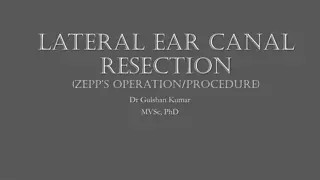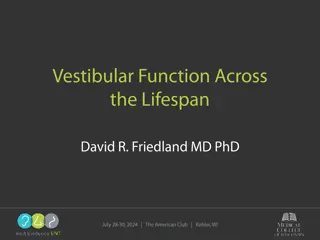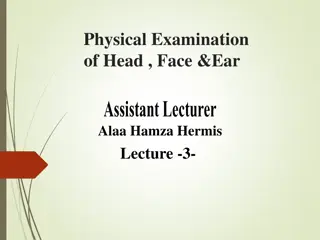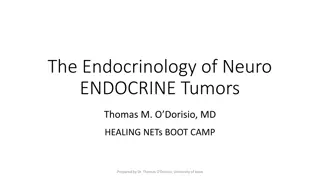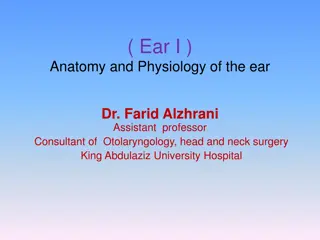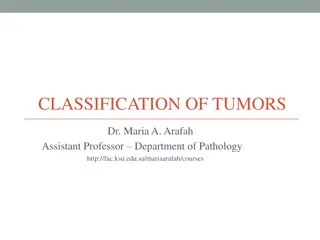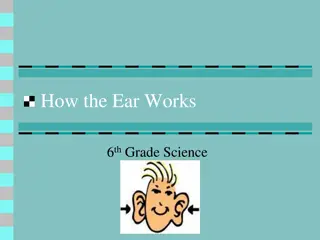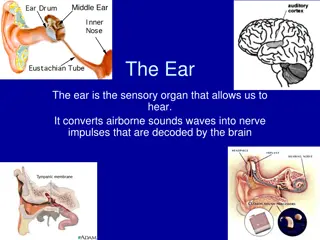Understanding Ear Tumors and Cholesteatoma: Causes, Symptoms, and Management
Ear tumors such as Glomus tumor and Acoustic neuroma can affect vital functions of the ear, leading to symptoms like tinnitus, vertigo, hearing loss, and facial nerve disorders. Surgical excision is a common treatment method. Cholesteatoma, an abnormal skin growth in the middle ear, can also cause complications. Understanding the causes and symptoms of these conditions is crucial for timely management.
Uploaded on Sep 26, 2024 | 0 Views
Download Presentation

Please find below an Image/Link to download the presentation.
The content on the website is provided AS IS for your information and personal use only. It may not be sold, licensed, or shared on other websites without obtaining consent from the author. Download presentation by click this link. If you encounter any issues during the download, it is possible that the publisher has removed the file from their server.
E N D
Presentation Transcript
Glomus tumor Tumor arises from specialized structures behind the eardrum Glomus tympanicum limited to the ear Glomus jugulare spread into the neck Its consider as an benign and slow growing but can destroy vital functions of ear, paralyze the face Surgical excision is curable surgery.
Acoustic neuroma (vestibular schwannoma) Most common lesion affecting the inner ear Benign tumor of the eight cranial nerve Slow growing lesion that occur in any age Unilateral The tumor grows at the point where cranial nerve VIII enters the internal auditory canal and extend into the brainstem. Common in women (30 to 60 years of age)
Pathophysiology Acoustic neuromas arise from the neurilemmal sheath (sheath of schwann) along the vestibular branch of vestibulocochlear nerve Spread to the cochlear branch Grow and compress the facial nerve and arteries Extend intracranially Hearing and facial nerve function reduced
Signs and symptoms Tinnitus Vertigo Progressive unilateral loss of ability to hear Disorders of facial nerve impaired movement and muscle weakness over face, drooping of lower eyelid Taste sensation may also be impaired.
Management Surgical excision - neurosurgeon CT scan is used to rule out the size of tumor The size more than 2 cm can leads to impaired hearing and facial nerve damage.
cholesteatoma An abnormal skin growth in the middle ear behind the eardrum is called cholesteatoma It often develop as a cyst or pouch that shed layers of old skin, which build up inside the middle ear It can increase in size and destroy the surrounding structures
Causes Due to poor Eustachian tube functioning Infection in the middle ear Or congenital
Pathophysiology Altered functioning of Eustachian tube or Incase of Allergy, a cold , or sinusitis Air in the middle ear is absorbed Creates a partial vacuum in the ear Vacuum pressure sucks in a pouch or sac by stretching the eardrum (especially weekend areas due to previous infections) This can later develop into a cyst called cholesteatoma
Signs and symptoms Drainage of fluid with foul odor As pouch or sac enlarges feeling of fullness or pressure in the ear Hearing loss Otalgia Dizziness or muscle weakness on one side of the face
Treatment Antibiotics Ear drops A complicated cholesteatoma requires surgical treatment Cholesteatoma should be surgically removed and a second surgery should be done to repair the damaged ear bones and tympanic membrane after 6 to 12 months later. Mastoidectomy or tympanoplasty used to do to remove cholesteatoma.
Malignancy of auricle A. Squamous cell carcinoma B. Melanoma it s a type of skin cancer in which melanocytes (pigment in skin) are affected. C. Basal cell carcinoma These cancers are very rare. Caused mainly due to increased exposure to sunlight Prevention can be done by wearing protective cloths and hats.











